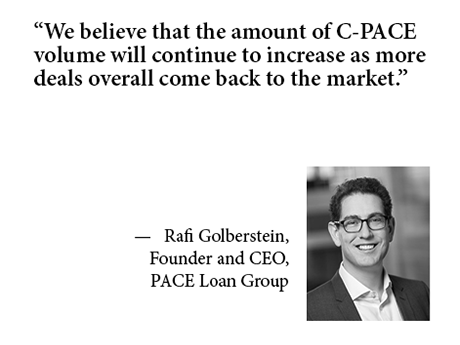The Federal Reserve’s decision to begin aggressively hiking the federal funds rate in 2022 threw the commercial real estate market into turmoil. Property investors found it difficult to refinance much cheaper short-term loans that were often used to renovate or develop properties.
However, the interest rate spike greatly enhanced the viability of commercial property assessed clean energy (C-PACE) financing, a type of loan that becomes an assessment that borrowers pay along with their tax bill. The program emerged more than a decade ago and generally pays for energy, water and seismic resiliency upgrades in new construction and rehabs, including retroactively. As a result, developers embraced C-PACE as they sought ways to pay down debt to secure new financing or loan extensions and modifications.
Sponsored: A smarter way to finance your next CRE project – PACE Loan Group
Now that the Federal Reserve has reversed course with its 50-basis-point federal funds rate reduction in September — and with Wall Street anticipating additional rate cuts before the end of the year — will C-PACE demand start to cool? Don’t count on it, says Rafi Golberstein, founder and CEO of PACE Loan Group, a direct lender of C-PACE financing based in Minneapolis, Minn.
From the competitive cost of capital to the continued restraints on bank lending, C-PACE remains an attractive funding source, he maintains. Plus, after years of hesitancy, more conventional lenders and brokers are beginning to grasp the benefits and flexibility offered by C-PACE as it spreads across the country.
“We believe that the amount of C-PACE volume will continue to increase as more deals overall come back to the market,” Golberstein states. “C-PACE has really matured through the years — we’ve gone from a large percentage of mom-and-pop borrowers in 2017 to institutional investors in 2024.”
Conventional Finance Parity
Despite the exuberance displayed over the Fed’s September cut, the Secured Overnight Financing Rate (SOFR), which serves as a benchmark for floating-rate bridge loans, remains elevated. It has dipped below 5 percent for the first time in more than a year, according to the Federal Reserve of New York, but it’s still at historical highs, especially considering the fact that it spent much of the pandemic and into 2022 at zero.
At the same time, PACE Loan Group has reduced its coupon rate by roughly 60 basis points, Golberstein points out. Additionally, unlike short-term debt fund capital, C-PACE is fixed-rate financing that’s typically paid off between 20 and 30 years, and borrowers don’t have to buy rate caps to hedge against rates re-spiking, he adds. In many cases, C-PACE can also account for up to 30 percent of a borrower’s capital stack, which can make deals more attractive to mortgage lenders.
“We are still significantly cheaper than debt fund money priced over SOFR, even if we do see SOFR tick down 50 more basis points,” Golberstein says. “I think we’re more or less going to stay in line with that delta.”
Meanwhile, some banks are offering interest rates about 50 to 75 basis points lower than C-PACE for the first time in about 18 months, Golberstein acknowledges. But banks remain cautious in this economy and are limiting the amount of proceeds they’re doling out amid problem real estate loans and regulatory scrutiny.
“Banks want to deploy capital, but they’re very conservative,” he explains. “They’re calling us to participate in loans where they can, say, provide $20 million but where the borrower needs $40 million.”
Expanding Market
Owners of offices, life science buildings and data centers, which have become harder to finance over the past couple of years, are driving a fair amount of PACE Loan Group’s business, Golberstein says. So, too, are developers of asset classes in high demand or in short supply — apartments, hotels and self-storage, to name a few — as they move off the sidelines to get a jump on the competition in anticipation of a lower rate environment. Investors in difficult markets, such as San Francisco are also fueling opportunities, he adds.
What’s more, C-PACE is becoming much more accessible. Since interest rates began climbing in March 2022, for example, a growing number of major commercial real estate brokers and lenders who for years ignored the financing tool have added it to their toolbox after realizing its effectiveness, Golberstein says.
States are following suit. Over 20 have added or expanded C-PACE programs over the last several months, bringing the number of states offering a clean energy capital option to nearly 40. New York City also published guidelines for using C-PACE in new construction, which heretofore hadn’t been allowed.
“What has happened legislatively across states and in New York City to advance C-PACE over the past year-and-a-half has just been gangbusters,” Golberstein declares. “It has been quite affirming for our business.”
— By Joe Gose. PACE Loan Group is a content partner of REBusinessOnline. To learn more about PACE Loan Group, click here, or access their Get a Quote form here.


